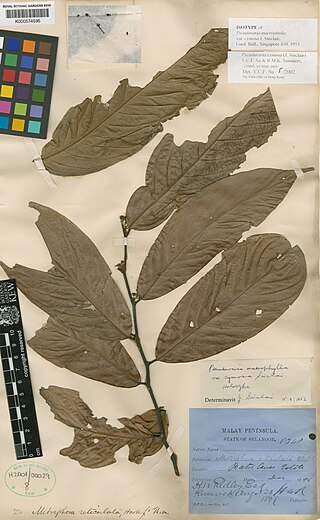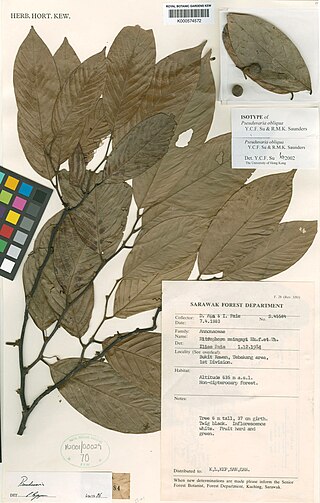Pseuduvaria cerina is a species of tree in the Annonaceae family. It is endemic to Peninsular Malaysia. James Sinclair, the Scottish botanist who first formally described the species, named it after its waxy yellow inner petals.

Pseuduvaria aurantiaca is a species of plant in the family Annonaceae. It is endemic to New Guinea. Friedrich Anton Wilhelm Miquel, the Dutch botanist who first formally described the species using the basionym Orophea aurantiaca, named it after its orange colored fruit.
Pseuduvaria beccarii is a species of plant in the family Annonaceae. It is endemic to New Guinea. Rudolph Scheffer, the Dutch botanist who first formally described the species using the basionym Orophea beccarii, named it after Odoardo Beccari, the Italian naturalist who collected the sample he examined.

Pseuduvaria bruneiensis is a species of plant in the family Annonaceae. It is endemic to Borneo. Yvonne Chuan Fang Su and Richard M.K. Saunders, the botanists who first formally described the species, named it after Brunei where the specimens they examined were collected.
Pseuduvaria clemensiae is a species of plant in the family Annonaceae. It is native to New Guinea. Yvonne Chuan Fang Su and Richard M.K. Saunders, the botanists who first formally described the species, named it after Mary Strong Clemens who collected the specimen they examined.
Pseuduvaria coriacea is a species of plant in the family Annonaceae. It is native to New Guinea. Yvonne Chuan Fang Su and Richard M.K. Saunders, the botanists who first formally described the species, named it after its leathery leaves.

Pseuduvaria cymosa is a species of plant in the family Annonaceae. It is native to Peninsular Malaysia. James Sinclair, the Scottish botanist who first formally described the species using the synonym Pseuduvaria macrophylla var. cymosa, named it after its branched inflorescences which are called cymes.
Pseuduvaria dielsiana is a species of plant in the family Annonaceae. It is native to New Guinea. Carl Lauterbach, the German botanist who first formally described the species using the synonym Goniothalamus dielsianus, named it in honor of Ludwig Diels, another German botanist who also worked on taxa from New Guinea.

Pseuduvaria glabrescens is a species of plant in the family Annonaceae. It is native to Australia. L.W. Jessup, the botanist who first formally described the species using the synonym Pseuduvaria mulgraveana var. glabrescens, named it after the underside of its leaves which have the quality of becoming hairless as they mature.
Pseuduvaria kingiana is a species of plant in the family Annonaceae. It is native to the Malay Peninsula. Yvonne Chuan Fang Su and Richard Saunders, the botanists who first formally described the species, named it after Sir George King, the British botanist who first collected the species.

Pseuduvaria luzonensis is a species of plant in the family Annonaceae. It is native to The Philippines. Elmer Drew Merrill, the American botanist who first formally described the species using the synonym Orophea luzoniensis, named it after Luzon in the province of Battan, Philippines where the specimen he examined was collected along the Lamao River.

Pseuduvaria macrocarpa is a species of plant in the family Annonaceae. It is native to The Maluku Islands and New Guinea. William Burck, the Dutch botanist who first formally described the species using the synonym Meiogyne macrocarpa, named it after its large fruit.
Pseuduvaria mindorensis is a species of plant in the family Annonaceae. It is native to the Philippines. Yvonne Su and Richard Saunders, the botanists who first formally described the species, named it after the island of Mindoro where the specimen they examined was collected in the municipality of Puerto Galera.

Pseuduvaria obliqua is a species of plant in the family Annonaceae. It is native to Borneo. Yvonne Su and Richard Saunders, the botanists who first formally described the species, named it after its slightly uneven leaf bases.
Pseuduvaria oxycarpa is a species of plant in the family Annonaceae. It is native to Sulawesi. Sijfert Hendrik Koorders, the Dutch botanist who first formally described the species, named it after the pointed tips of its fruit.

Pseuduvaria pamattonis is a species of plant in the family Annonaceae. It is native to Borneo and the Philippines. Friedrich Miquel, the Dutch botanist who first formally described the species using the basionym Orophea pamattonis, named it after a mountain in Borneo called Gunung Pamaton.
Pseuduvaria parvipetala is a species of plant in the family Annonaceae. It is native to Borneo and Sumatra. Yvonne Su and Richard Saunders, the botanists who first formally described the species, named it after its small petals.

Pseuduvaria reticulata is a species of plant in the family Annonaceae. It is native to Bangladesh, Borneo, Java, the Lesser Sunda Islands, Myanmar and Sumatra. Carl Ludwig Blume, the botanist who first formally described the species under the basionym Uvaria reticulata, named it after the net-like pattern of veins on the underside of its leaves.
Pseuduvaria trimera is a species of plant in the family Annonaceae. It is native to China, Myanmar, Thailand, and Vietnam. William Grant Craib, the British botanist who first formally described the species, named it after its fascicles of flowers that often occur in three parts.

Pseuduvaria unguiculata is a species of plant in the family Annonaceae. It is endemic to The Philippines. Adolph Daniel Edward Elmer, the American botanist who first formally described the species, named it after its clawed inner petals.











